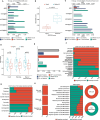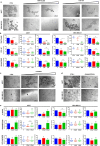AI identifies potent inducers of breast cancer stem cell differentiation based on adversarial learning from gene expression data
- PMID: 38701411
- PMCID: PMC11066897
- DOI: 10.1093/bib/bbae207
AI identifies potent inducers of breast cancer stem cell differentiation based on adversarial learning from gene expression data
Abstract
Cancer stem cells (CSCs) are a subpopulation of cancer cells within tumors that exhibit stem-like properties and represent a potentially effective therapeutic target toward long-term remission by means of differentiation induction. By leveraging an artificial intelligence approach solely based on transcriptomics data, this study scored a large library of small molecules based on their predicted ability to induce differentiation in stem-like cells. In particular, a deep neural network model was trained using publicly available single-cell RNA-Seq data obtained from untreated human-induced pluripotent stem cells at various differentiation stages and subsequently utilized to screen drug-induced gene expression profiles from the Library of Integrated Network-based Cellular Signatures (LINCS) database. The challenge of adapting such different data domains was tackled by devising an adversarial learning approach that was able to effectively identify and remove domain-specific bias during the training phase. Experimental validation in MDA-MB-231 and MCF7 cells demonstrated the efficacy of five out of six tested molecules among those scored highest by the model. In particular, the efficacy of triptolide, OTS-167, quinacrine, granisetron and A-443654 offer a potential avenue for targeted therapies against breast CSCs.
Keywords: artificial intelligence; breast cancer; cancer stem cells; domain adaptation; drug repurposing; transcriptomics.
© The Author(s) 2024. Published by Oxford University Press.
Figures





Similar articles
-
Development and Validation of a Convolutional Neural Network Model to Predict a Pathologic Fracture in the Proximal Femur Using Abdomen and Pelvis CT Images of Patients With Advanced Cancer.Clin Orthop Relat Res. 2023 Nov 1;481(11):2247-2256. doi: 10.1097/CORR.0000000000002771. Epub 2023 Aug 23. Clin Orthop Relat Res. 2023. PMID: 37615504 Free PMC article.
-
Cost-effectiveness of using prognostic information to select women with breast cancer for adjuvant systemic therapy.Health Technol Assess. 2006 Sep;10(34):iii-iv, ix-xi, 1-204. doi: 10.3310/hta10340. Health Technol Assess. 2006. PMID: 16959170
-
Leveraging a foundation model zoo for cell similarity search in oncological microscopy across devices.Front Oncol. 2025 Jun 18;15:1480384. doi: 10.3389/fonc.2025.1480384. eCollection 2025. Front Oncol. 2025. PMID: 40606969 Free PMC article.
-
Drugs for preventing postoperative nausea and vomiting in adults after general anaesthesia: a network meta-analysis.Cochrane Database Syst Rev. 2020 Oct 19;10(10):CD012859. doi: 10.1002/14651858.CD012859.pub2. Cochrane Database Syst Rev. 2020. PMID: 33075160 Free PMC article.
-
Linking transcriptome and morphology in bone cells at cellular resolution with generative AI.J Bone Miner Res. 2024 Dec 31;40(1):20-26. doi: 10.1093/jbmr/zjae151. J Bone Miner Res. 2024. PMID: 39303095
Cited by
-
Discovering the Potential Role of the C2 DUSP2+ MCs Subgroup in Lung Adenocarcinoma.Transl Oncol. 2025 Apr;54:102295. doi: 10.1016/j.tranon.2025.102295. Epub 2025 Feb 26. Transl Oncol. 2025. PMID: 40014976 Free PMC article.
-
Enhancing the clinical translation of stem cell models by focusing on standardization and international regulatory cooperation.World J Stem Cells. 2025 Apr 26;17(4):102788. doi: 10.4252/wjsc.v17.i4.102788. World J Stem Cells. 2025. PMID: 40308886 Free PMC article.
-
Cancer stem cells: landscape, challenges and emerging therapeutic innovations.Signal Transduct Target Ther. 2025 Aug 5;10(1):248. doi: 10.1038/s41392-025-02360-2. Signal Transduct Target Ther. 2025. PMID: 40759634 Free PMC article. Review.
-
Protein Marker-Dependent Drug Discovery Targeting Breast Cancer Stem Cells.Int J Mol Sci. 2025 Aug 17;26(16):7935. doi: 10.3390/ijms26167935. Int J Mol Sci. 2025. PMID: 40869256 Free PMC article. Review.
References
Publication types
MeSH terms
Grants and funding
LinkOut - more resources
Full Text Sources
Medical
Miscellaneous

